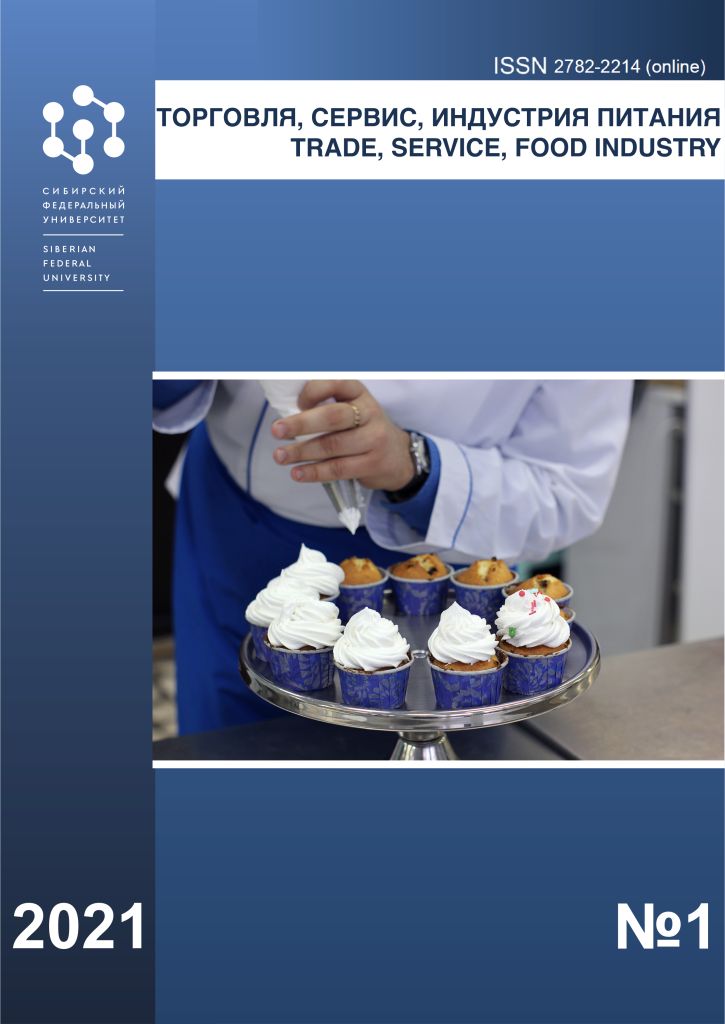Krasnoyarsk, Russian Federation
Krasnoyarsk, Krasnoyarsk, Russian Federation
Krasnoyarsk, Russian Federation
CSCSTI 06.81
The development of competition in the retail sales market determines the development of methodological and practical approaches to the formation and diagnosis of the assortment of goods sold. The issues of optimizing the assortment policy are reflected in the works of both foreign and domestic researchers for a significant period of time, but there is a possibility to expand the tools of such studies. In practice of retail enterprises, due to various sales formats, location, volumes of activity and other factors, in many cases it is difficult to use knowledge-intensive econometric models for assortment diagnostics, and therefore there is a need to form tools that are user-friendly in a variety of operating conditions. The aim of the study is to develop approaches to the diagnosis of the formation of the assortment of a retail enterprise based on the synthesis of existing methods and techniques. The article defines the concept of sales profitability in the framework of assortment diagnostics, taking into account the specifics of income generation in trade. In addition, basic methodological approaches to the formation of a retail assortment from the standpoint of merchandising, marketing and category management are summarized and structured, that enabled to prove the possibility of an assortment diagnosis using a matrix combining the ABC-analysis of profitability and XYZ-analysis of the stability of sales for the formation of the basic classes of goods. The proposed methodology will expand the tools for diagnosing the assortment of retail trade enterprises and will allow making adequate management decisions on its optimization to increase the effectiveness of the functioning of retail sales entities.
profitability of sales, assortment, trade assortment, assortment policy, assortment formation, assortment diagnostics, category management, assortment improvement
1. Sheremet, A.D. (2010). Kompleksnyi analiz khozyaistvennoi deyatel'nosti. Moscow. INFRA-M. 416 p. (in Russian)
2. Lopatnikov, L.I. (2013). Economic and Mathematical Dictionary: Dictionary of modern Economic science. Moscow. Delo. 520 p. (in Russian)
3. Dictionary-reference of economic terms. Available from: http://abc.vvsu.ru/books/slovar_eco/page0001.asp (accessed 21.12.2020) (in Russian)
4. Blank, I.A. (2007). Fundamentals of Financial management. Kiev. El'ga; Nika-Tsentr. 654 p. (in Russian)
5. Darbiyan, V.I. (2011). The formation of the range and of the stock in trade. Moscow. Ekonomika (in Russian)
6. Lisovskii P. (2012). Managerial perspectives of assortment planning in a retail network // Economist's Handbook. No 7. Pp. 54-66 (in Russian)
7. Dashkov, L. P., Pambukhchiyants, V. K., Pambukhchiyants O. V. (2012). Commerce and Trade Technology. 11 ed. Moscow. Dashkov i K°. 354 p. (in Russian)
8. Paramonova, T.N., Krasyuk, I.N., Kalugina, S.A., Komarov, V.M. et al. (2016). Marketing. Moscow. KNORUS. 358 p. (in Russian)
9. Nikitkin, V.V. (2013). Retail Marketing: Theory and methodology. Moscow. Ekonomika. 210 p. (in Russian)
10. Nikolaeva, M.A. (2015). Product Policy. Moscow. Norma; INFRAM. 256 p. (in Russian)
11. Balakirev, S. (2011). Product range management. Modern trade. No 2. P. 26-33. (in Russian)
12. Komakha, A. Assortment policy. Available from: http://marketing.spb.ru (accessed 21.12.2020) (in Russian)
13. State standard R 51773-2009. Trade services. Classification of trade enterprises. - Available from: /http://www.rags.ru/gosts/gost/6841/ (accessed 21.12.2020) (in Russian)
14. Afanas'ev, V.A. (2014). Marketing in the management of the company's product range. Leather and footwear industry. No 3(4) (in Russian)
15. Sysoeva S.V. (2010). Management of the assortment in retail. Category management. St. Petersburg. Piter. 45 p. (in Russian)
16. Garvis, M. (2010). 4 Strategies to optimize assortment planning. Quantum Retail Technology. No 1. Pp. 3-15.
17. Ferreira, K. J., Joel, G. (2016). Assortment Rotation and the Value of Concealment. Harvard Business School Working Paper. 17-041.
18. Balan, M. (2014). The Theory and Practice of Optimizing Assortment and Space. The Category Management Association. 46.
19. Kok, A. G., Fisher, M.L. (2007). Demand Estimation and Assortment Optimization Under Substitution. Methodology and Application. Operation Research. No 55 (6). Pp. 1001-1021.
20. Bahng, Y., Rogers F.T., Kincade D.H. (2018). Assortment Planning for Retail Buying, Retail Store Operations, and Firm Performance. Journal of Distribution Science. 16 (8). Pp. 15-27. doi:https://doi.org/10.15722/jds.16.8.201808.15
21. Rooderkerk, R.P., Heerde, H.J., Bijmolt, T.H.A. (2013). Optimizing Retail Assortments. Marketing Science. No 32 (5). Pp. 699-715. doi:https://doi.org/10.1287/mksc.2013.0800
22. Proshkina, O.V., Efremova, O.I. (2019). Methodology of forming the assortment policy of the enterprise. IIOABJ. No 10 (3). Pp. 89-92.
23. Kok, A.G., Fisher, M.L., Vaidyanathan, R. (2006). Assortment Planning: Review of Literature and Industry Practice. Pennsylvania: Kluwer Publishers. 46.
24. Esina, O. N. (2017). Development of theoretical approaches to the formation of the company's product range in unstable conditions. In: Regional market in crisis conditions. Krasnoyarsk. SibFU. Pp. 630-634 (in Russian)
25. Lukinskii, V. S. (2014). Applied methods and models in logistics. Logistika segodnya. No 6. P. 32-40 (in Russian)
26. Bodryakov, R. ABC- & XYZ-analysis: compilation and analysis of the final matrix. Available from: http://www.loglink.ru/massmedia/analytics/record/?id=275/ (accessed 23.12.2020) (in Russian)








